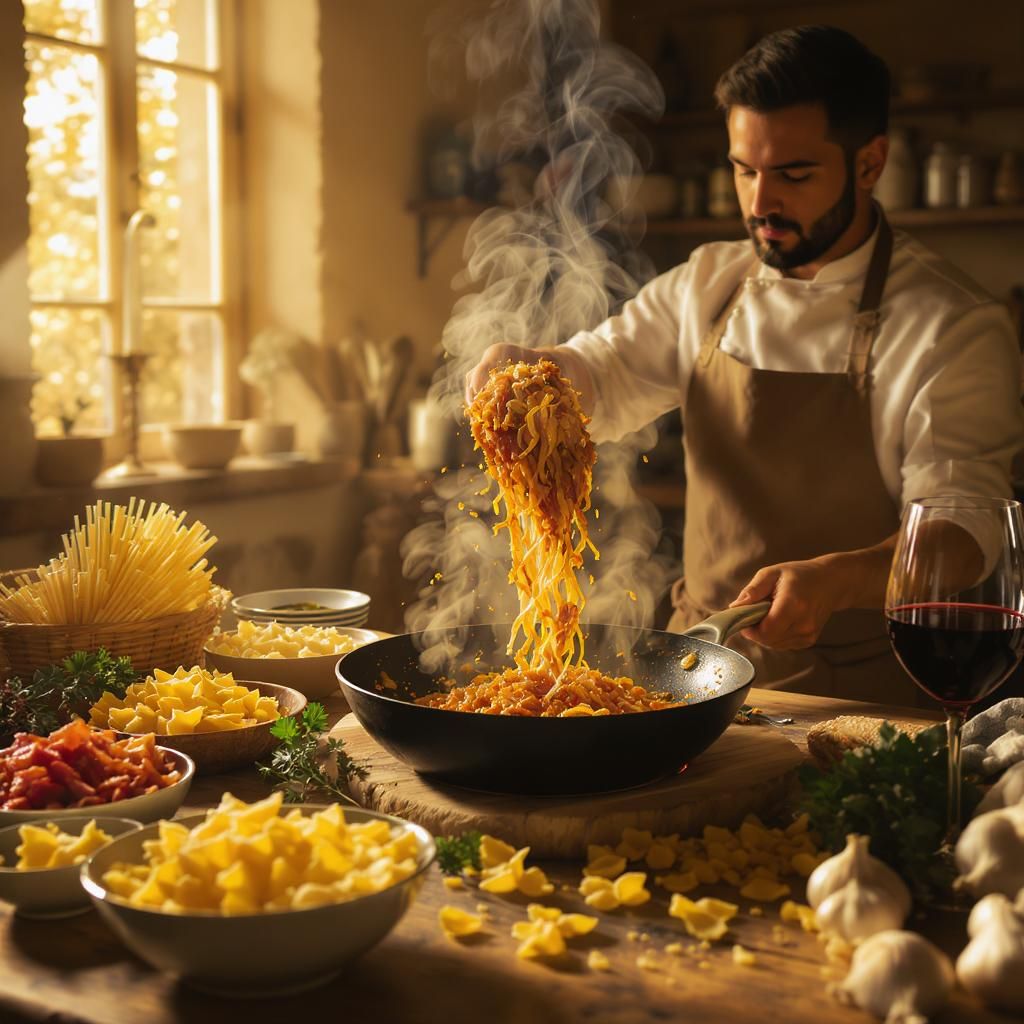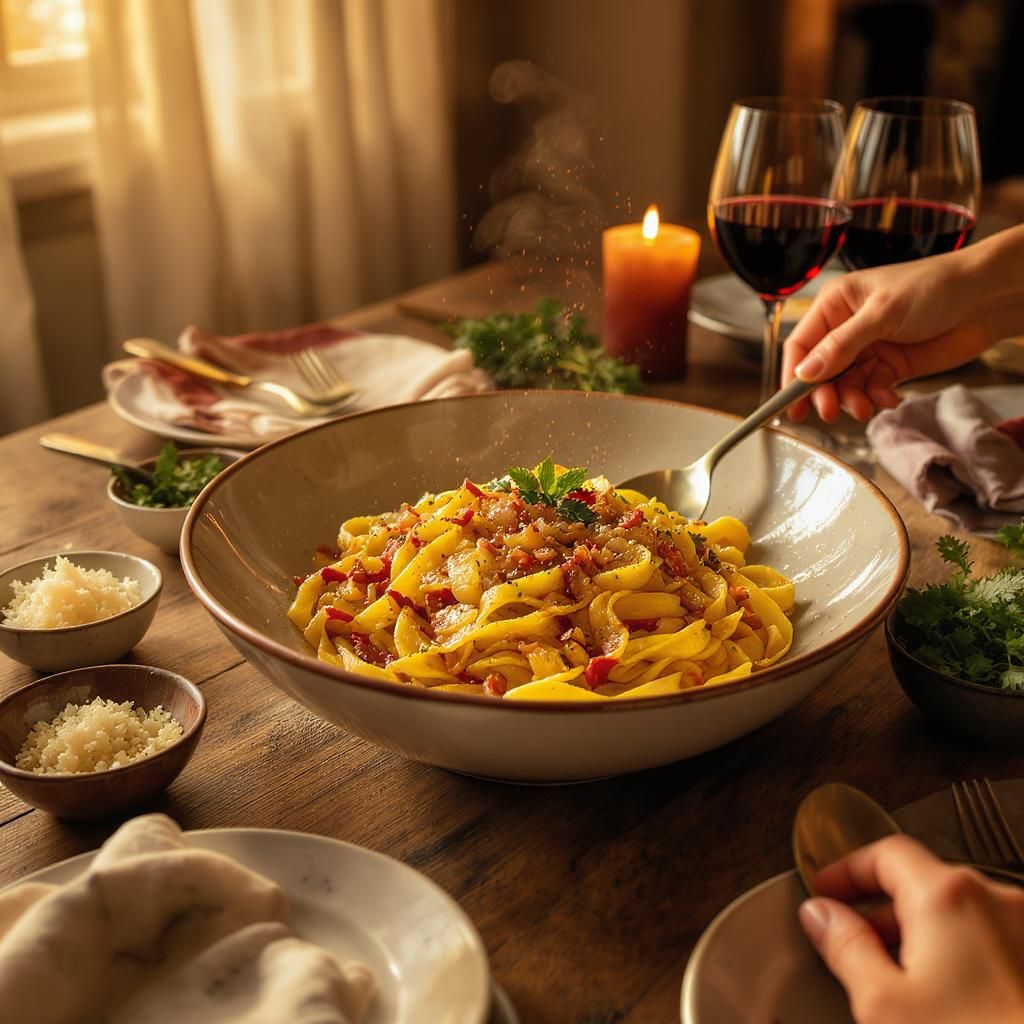Caramelized onion pasta is a delicious dish that combines the rich, sweet flavor of slowly cooked onions with pasta. To prepare it, sauté sliced onions in olive oil until golden brown, then toss with cooked pasta, garlic, and a splash of vegetable broth. Finish with Parmesan cheese and fresh herbs for a satisfying, savory meal.
Caramelized Onion Pasta is a delightful dish that combines the rich, sweet flavors of slow-cooked onions with al dente pasta. It’s a cozy meal that’s perfect for any occasion, and it’s surprisingly simple to make!
Understanding Caramelization: The Heart of the Dish

When I first set out to create a recipe for Caramelized Onion Pasta, I quickly realized that the process of caramelizing onions is the key to achieving that deep, sweet flavor that makes this dish so special. Caramelization is a cooking technique that transforms the natural sugars in onions through prolonged heat, resulting in a rich brown hue and a complex flavor profile. This transformation doesn’t happen overnight; it requires patience and a bit of technique, but the results are incredibly rewarding.
The Science Behind Caramelization
As I began to explore the science behind caramelization, I discovered that it starts with the breakdown of sugars in the onions. When I heat onions in a pan, the sugars begin to release, and with time and the right temperature, they start to brown. It’s crucial to keep the heat low and allow the onions to cook slowly—rushing this process often results in burnt onions rather than the sweet, golden-brown gems I was aiming for.
To properly caramelize onions, I usually slice them thinly, which helps them cook evenly. I typically choose yellow onions for their natural sweetness, but I’ve also experimented with red and white onions, each offering a unique flavor. The key is to use a heavy-bottomed skillet that retains heat well, allowing for an even cooking surface.
How to Caramelize Onions
Here’s how I’ve mastered the art of caramelizing onions: First, I heat a tablespoon of olive oil (or sometimes butter for an added richness) in a heavy skillet over medium heat. Once the oil shimmers, I add my sliced onions. Right from the start, I sprinkle a pinch of salt, which helps draw out moisture and encourages the onions to soften. I find that stirring them occasionally prevents sticking and burning while allowing for even cooking.
After about 10-15 minutes, I lower the heat to medium-low. At this point, I’ve learned that patience is essential. I let the onions cook slowly, stirring every few minutes, allowing them to transform from translucent to golden brown. This process can take anywhere from 30 minutes to an hour, depending on the amount of onions I’m using. The aroma that fills my kitchen during this time is like nothing else—I can hardly wait to make my pasta!
Enhancing the Flavor
As my onions begin to caramelize, I love to experiment by adding other ingredients to enhance the flavor further. A splash of balsamic vinegar or a sprinkle of thyme can elevate the dish to another level. If I’m feeling adventurous, I might even throw in a touch of red wine, which adds an extra depth of flavor that complements the sweetness of the onions beautifully. I’ve found that these additions not only enhance the taste but also add a wonderful aroma that makes the cooking experience even more enjoyable.
Pasta Selection: Choosing the Right Base

While the caramelized onions are the stars of the dish, the type of pasta I choose plays a significant role in the overall experience. I prefer using a pasta shape that can hold onto the sauce well—something like fettuccine, tagliatelle, or even robust whole wheat pasta. I find that long, flat noodles do an excellent job of capturing the sweet, savory onion mixture, ensuring that each bite is flavorful.
When cooking the pasta, I make sure to season the water generously with salt. This step is crucial as it’s the only chance I get to flavor the pasta itself. I usually cook the pasta until al dente, allowing it to maintain a slight bite. Once cooked, I reserve a bit of the pasta water before draining, as this starchy liquid can help to meld the sauce and pasta together later on.
Bringing It All Together
Once my onions are perfectly caramelized and my pasta is cooked, the next step is to bring everything together. I like to combine the two in the skillet with the caramelized onions, adding a splash of the reserved pasta water to help create a cohesive sauce. This little trick makes a world of difference, allowing the flavors to marry beautifully. I often finish the dish with a drizzle of extra virgin olive oil and a generous sprinkle of freshly grated Parmesan cheese. The creamy, nutty cheese adds richness that perfectly complements the sweetness of the onions.
In my experience, the best part about cooking Caramelized Onion Pasta is how adaptable the dish is. I can easily add vegetables like spinach or mushrooms for extra nutrition, or toss in some cooked protein, like chicken or shrimp, for a heartier meal. This versatility makes it a go-to recipe in my kitchen, as it can be tailored to whatever I have on hand.
Serving Suggestions: Elevating the Experience

When it comes to serving my Caramelized Onion Pasta, I believe presentation and accompanying elements can truly elevate the entire dining experience. I often think about how I can complement this dish with sides or garnishes that enhance the flavors and overall feel of the meal.
One of my favorite accompaniments is a simple arugula salad, dressed lightly with lemon juice and olive oil. The peppery bite of the arugula contrasts beautifully with the sweetness of the caramelized onions, creating a well-balanced meal. Sometimes, I toss in some cherry tomatoes for a burst of freshness and color. The key here is to keep the salad light and refreshing, ensuring it doesn’t overshadow the pasta.
Another wonderful option is to serve the pasta alongside crusty garlic bread. I love to make my own by slicing a baguette, brushing the pieces with garlic-infused olive oil, and toasting them in the oven. The crunchy texture and aromatic garlic flavor are a perfect match for the rich, savory pasta. I often find myself reaching for the bread to scoop up any remaining sauce on my plate, and it adds a delightful tactile experience to the meal.
Pairing with Wine
No meal is complete without a thoughtful wine pairing in my opinion, and Caramelized Onion Pasta is no exception. I tend to gravitate towards white wines that have a bit of body, such as a Chardonnay or a Sauvignon Blanc. The crispness of these wines complements the sweetness of the onions while balancing the richness of the pasta and cheese. If I’m in the mood for red, I might opt for a light Pinot Noir, which offers enough acidity to cut through the dish’s richness while enhancing the caramelized notes of the onions.
When I’m hosting a dinner party, I often set up a little wine tasting station where guests can sample different options. It adds an interactive element to the meal and encourages conversation about the flavors and pairings. I cherish these moments when I can share my love for food and wine with friends and family, making the dining experience memorable.
Storing Leftovers
One of the things I’ve learned is that Caramelized Onion Pasta can be a fantastic dish for meal prep. If I happen to have leftovers, I always make sure to store them properly. I let the pasta cool before transferring it to an airtight container, where it can be refrigerated for up to three days. When I’m ready to enjoy the leftovers, I reheat them gently on the stove with a splash of water or broth to revive the sauce. I add a touch more cheese to freshen it up, and it tastes almost as good as the first time around.
I’ve also discovered that this dish freezes quite well. When I want to save a batch for later, I portion out the pasta and sauce separately (to prevent the pasta from becoming mushy) and store them in freezer-safe containers. This way, I can pull out a portion whenever I’m craving a comforting meal without much effort. There’s something incredibly satisfying about having a homemade dish ready to go, especially on busy days.
Experimenting with Variations

The beauty of Caramelized Onion Pasta lies in its adaptability. I’ve found that experimenting with different ingredients allows me to create endless variations, making it a dish I can enjoy time and time again without growing tired of it.
For instance, I’ve explored adding roasted vegetables like zucchini or bell peppers. Their sweetness complements the onions beautifully, and they add a lovely color to the dish. Another variation I love is incorporating different types of cheese; sometimes I use goat cheese for a tangy kick or Gorgonzola for a more intense flavor. These small tweaks can completely change the character of the dish, keeping it exciting.
If I want a creamier texture, I occasionally stir in a splash of heavy cream or crème fraîche as I combine the pasta and onions. This creates a luscious sauce that clings to the noodles, transforming the dish into a richer experience. For those who enjoy a bit of heat, I’ve been known to sprinkle in some red pepper flakes or add sautéed chili peppers for a spicy twist.
On days when I’m craving something lighter, I’ll swap out traditional pasta for zucchini noodles or whole-grain options, which add a different nutritional profile while still delivering on flavor. It’s amazing how versatile this dish can be, accommodating various dietary preferences without sacrificing taste.
Final Thoughts
Caramelized Onion Pasta has truly become a staple in my kitchen, not only for its deliciousness but also for its adaptability. I love how it allows me to express creativity while still being comfort food at its core. Whether I’m enjoying it solo, sharing it with friends, or experimenting with new ingredients, this dish always brings joy to my cooking experience. I encourage you to try making it yourself and see how you can personalize it to fit your tastes. Happy cooking!
